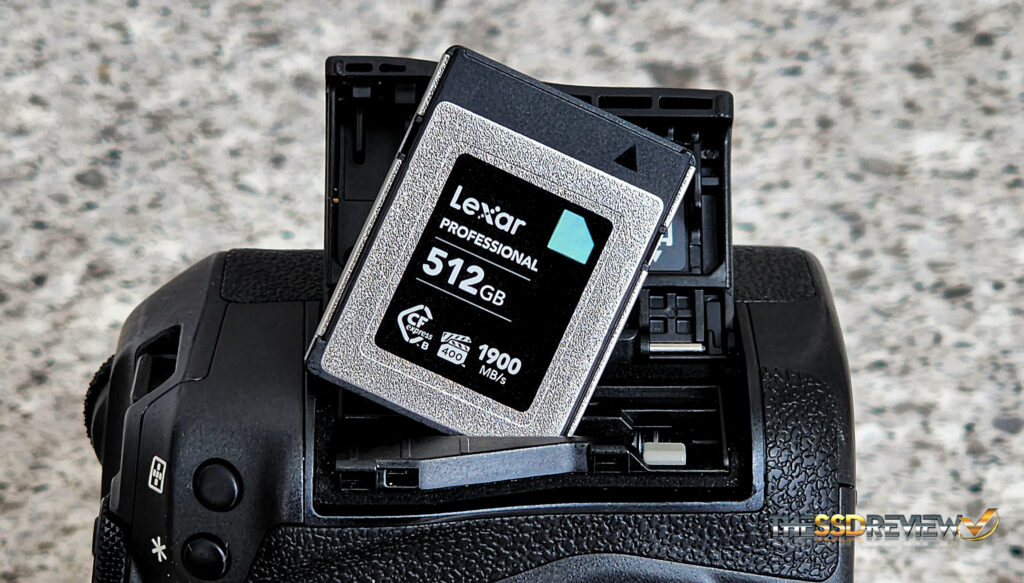Some time ago we posted an article on the latest and greatest in CFExpress Type B cards with our Lexar Professional Diamond 128GB and its unique ability to provide a sustained write performance of just under 1600MB/s. After all, sustained write speeds are everything in the world of digital media and, earlier CFExpress Type B cards that could not hold a sustained write of just above 300MB/s, even affected the features available to the user in cameras such as the Canon EOS R5. Absolute truth, higher recording resolutions were simply greyed out…but we are passed that now.
In fact, it isn’t such a hard reach to believe that the implementation of the VPG400 standard (minimum 400MB/s sustained write) was put forth completely as a result of this. Fortunately, we are well passed that with higher calibre cards maxing out at 4x that in sustained writes with higher capacity cards now being required for those media professionals jumping up to 8K recording and manipulation as their norm. We are always trying to achieve that perfect triangle of speed, capacity and pricing. Our report today achieves that capacity range somewhat as we are reporting on Lexar’s newest Professional Diamond CFExpress Type B Card in its newly released 512GB capacity.
The Lexar Professional Diamond is unquestionable one of the best CFExpress Type B cards available today and comes in 128, 256 and 512GB capacities. It is PCIe 3.0 x 2 (2 lanes), uses the NVMe 1.4 protocol, fully backwards compatible to XQD, and is one of the only cards available that comes with a limited lifetime warranty. Performance is listed at 1900MB/s read and 1700MB/s write with a 1600MB/s sustained write performance guaranteed. It also meets the newest VPG400 specification and then some.
Perhaps an understanding of where such high sustained write performance will find its sweet spot might help here, considering most cameras can only make use of just over 300MB/s when recording while simultaneously moving data to the card. The higher performance is a content creators dream as its main use is moving data to and from the card, data such as newer 8K recordings which are so large that 512GB and larger cards are a blessing. Check out Lexar Professional CFExpress Type B Diamond Series pricing at Amazon.
TSSDR TEST BENCH AND PROTOCOL
SSD testing at TSSDR differs slightly, depending on whether we are looking at consumer or enterprise storage media. For our Lexar Professional Diamond testing today, our goal is to test in a system that has been optimized with our SSD Optimization Guide.
For this Test Bench, there are no bios performance tweaks whatsoever and the new ASUS Maximus Z790 Hero brought us to over 6GHz while the newest Kingston Renegade Fury DDR-5 memory rests comfortably at 7200MHz.
The components of this Test Bench are detailed below. All hardware is linked for purchase and product sales may be reached by a simple click on the individual item.
INTEL Z790 PCIE 5.0 COMPONENTS
| PC CHASSIS: | Corsair 5000D RGB White Tempered Glass Chassis |
| MOTHERBOARD: | ASUS ROG Maximus Z790 Hero Gen 5 |
| CPU: | Intel 13th Gen Core i9-13900K |
| CPU COOLER: | Corsair Hydro Series H150i Capellix White |
| POWER SUPPLY: | Corsair HX1000i Platinum Modular 80Plus |
| GRAPHICS: | ZOTAC GeForce RTX 3080 Trinity White |
| MEMORY: | Kingston Renegade Fury RGB DDR5-7200 32GB |
| STORAGE: | Sabrent Rocket 4 Plus Gen 4 4TB NVMe SSD |
| KEYBOARD: | Corsair K70 PRO RGB Optical Mechanical Gaming |
| MOUSE: | Corsair M65 RGB Elite FPS Gaming |
| MONITOR: | Samsung 34? 1440p WQHD Ultrawide Gaming |
BENCHMARK SOFTWARE
The software in use for today’s analysis is typical of many of our reviews and consists of Crystal Disk Info, ATTO Disk Benchmark, Crystal Disk Mark, Anvil’s Storage Utilities, AJA, TxBench, as well as Sustained Disk Transfer, Temperature and True Data Transfer Rate Testing. Our selection of software allows each to build on the last and to provide validation to results already obtained.
For our testing today, we will be relying on the pictured PCIe 3.0 x4 CFExpress reader created for us by Lexar some time ago. As a bit of confirmation, we always test with multiple readers we have on hand and of both the ThunderBolt 3 and the newer USB 3.2 2×2 spec. One of those readers is Lexar’s own CFExpress USB 3.2 2×2 Card Reader which is a 20Gbps device that allows data transfer speeds up to the industry standard and to a theoretical max of 2GB/s. It is available and found at Amazon for $77.99.
There shouldn’t be a difference in any of these devices as the top speed of CFExpress is well below the threshold of all readers ( and our AIC Gen 3 reader), whether they be Thunderbolt 3/4 with a threshold of 2.8GB/s or USB 3.2 2×2 with a top speed of 2GB/s.
 The SSD Review The Worlds Dedicated SSD Education and Review Resource |
The SSD Review The Worlds Dedicated SSD Education and Review Resource | 

